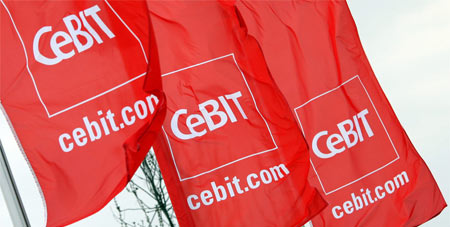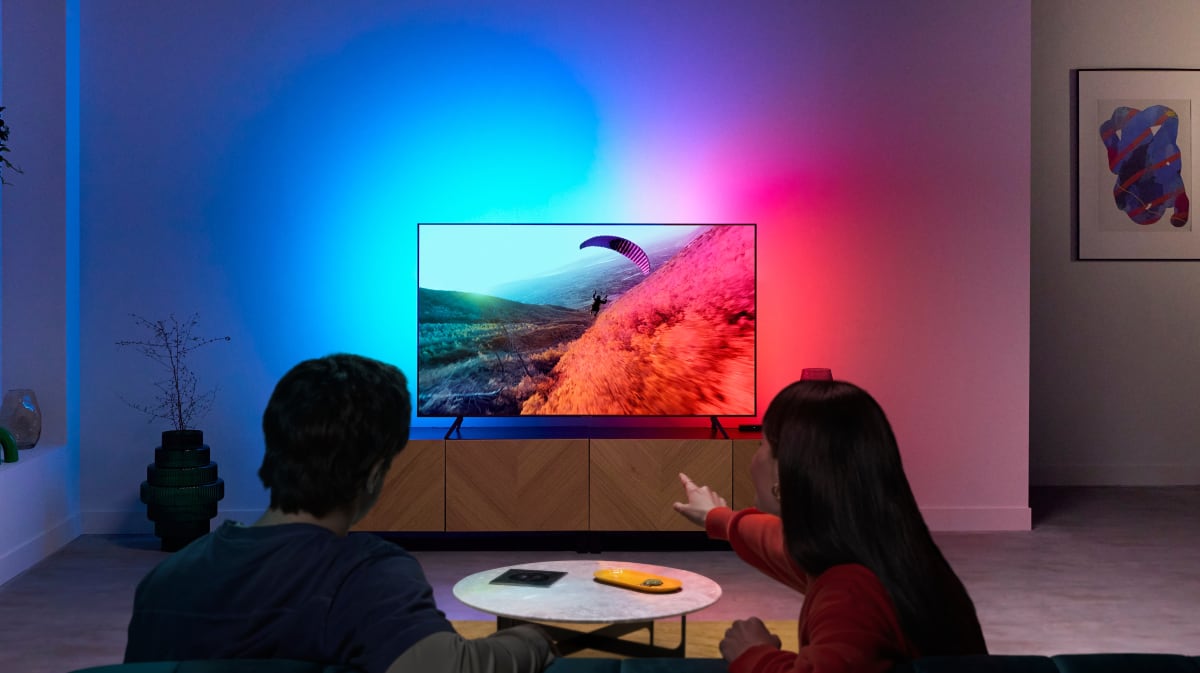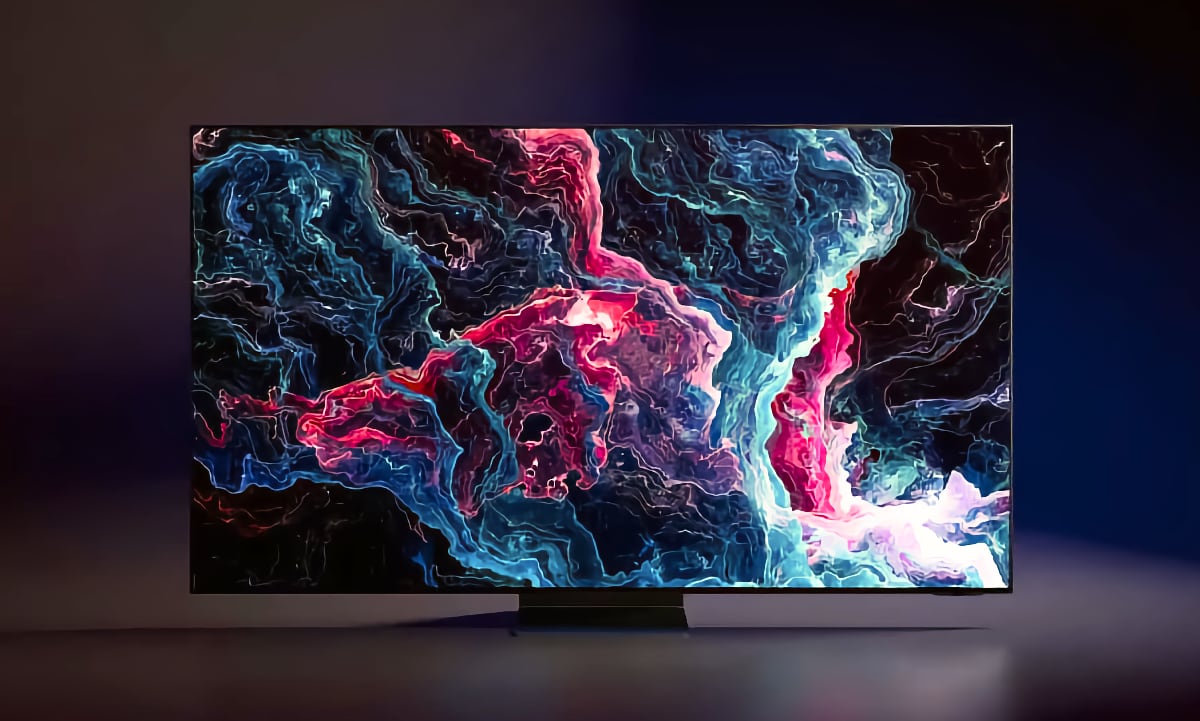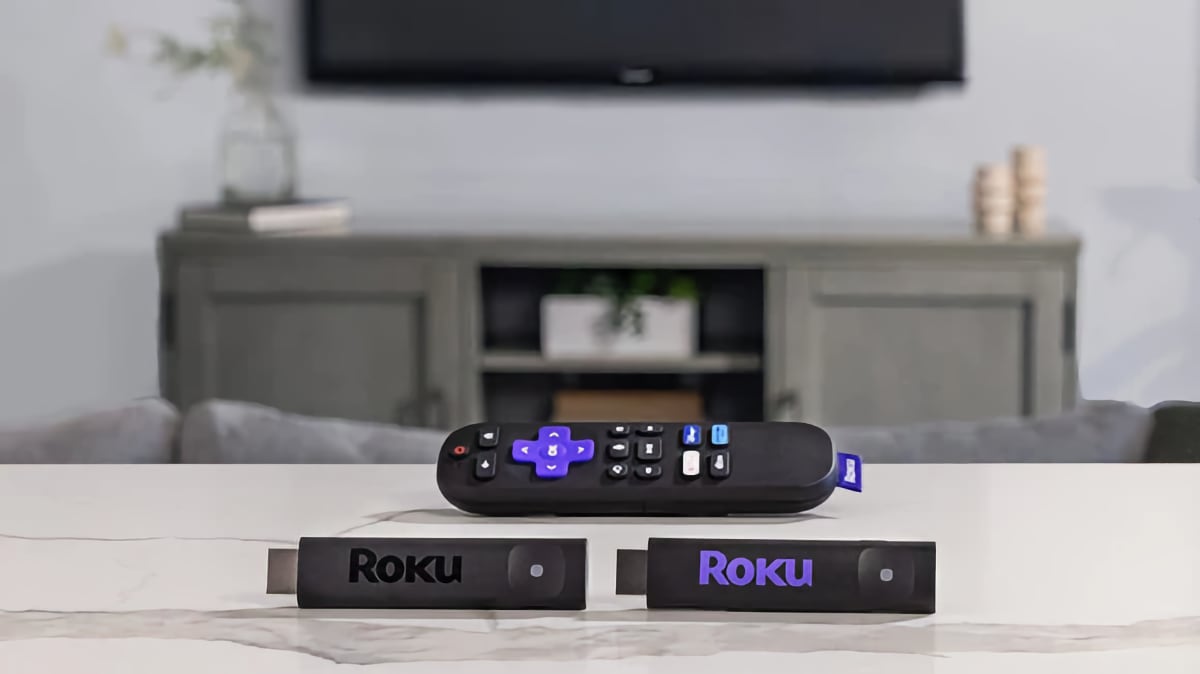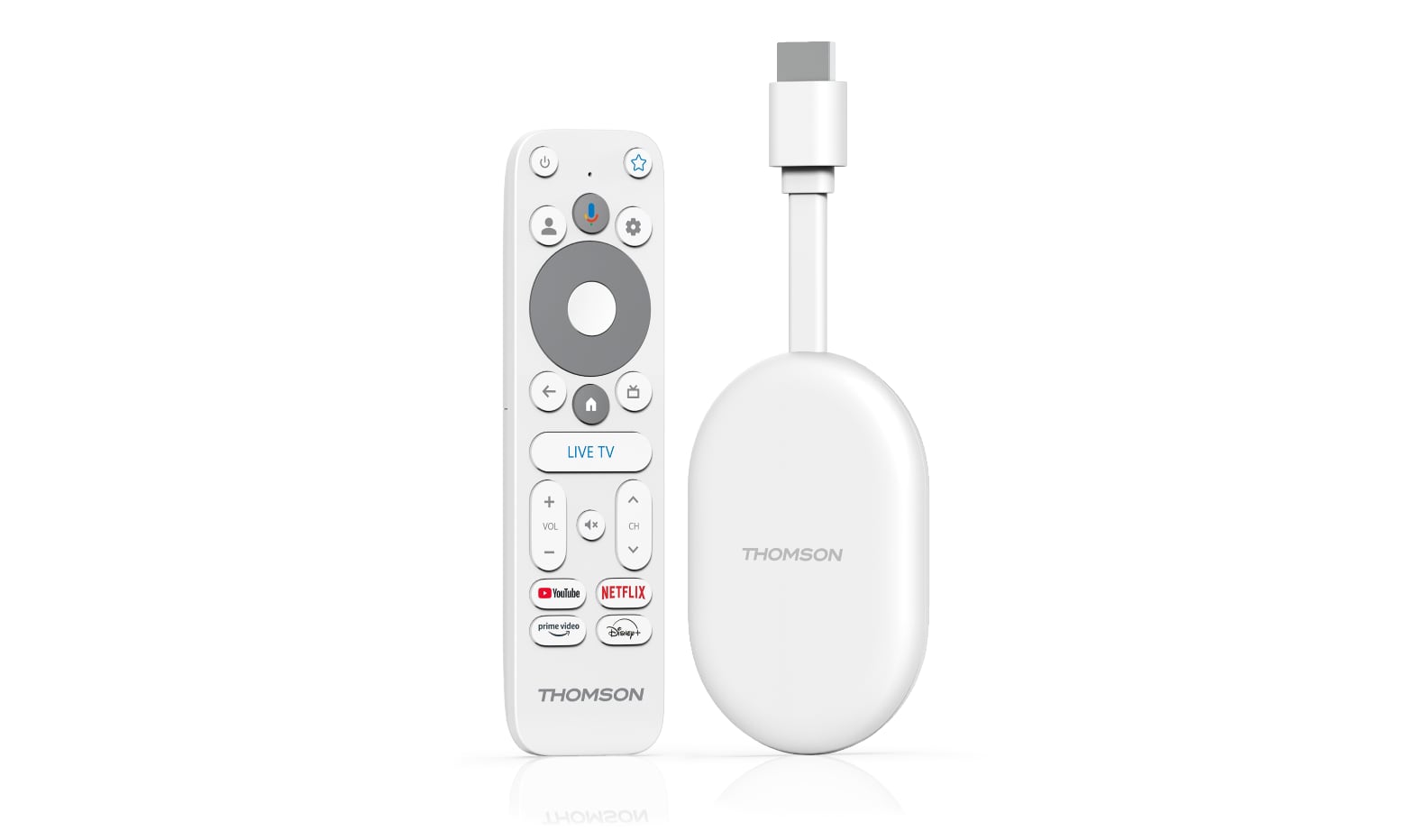CeBIT is one of the largest electronic fair in the world. The European CeBIT is hosted in Hannover, Germany and lasts 6 days. Flatpanels took a trip to CeBIT 2006 and this year we went to CeBIT again for the 2007 edition.
NB:This article has a lot of pictures so give it some time to load.
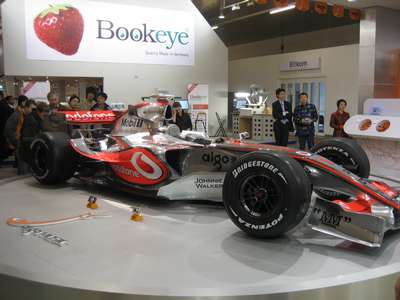
F1 car
CeBIT has been amputated.Big players such as Philips, LG and Pioneer didn’t attend. There were enough to see though and a lot of interesting new products and technologies from Samsung, Panasonic, Toshiba and Sharp.
Samsung
Samsung had smaller booth than they had at last year’s CeBIT and focus seemed to have shifted to other products. We still managed to find a lot monitors and TVs though. I’ll start off with this 22 inch monitor/TV. The duo-product has a TV tuner, HDMI, DVI, D-SUB (VGA), component, s-video, composite and scart.
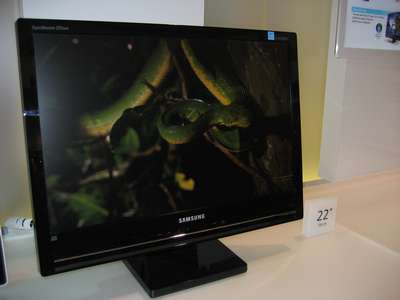
Samsung 225MW
It also supports 1080p inputs and has 2x3 Watt loudspeakers.
I found these Samsung LED LCD monitor too. They were presented at last year’s CeBIT too and are called the XL series.
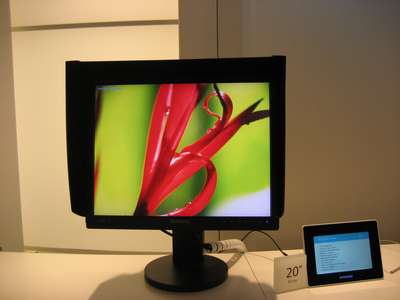
Samsung XL20
Here you see the 20 inch named XL20. The colour specter is 123 % but no information on which specter Samsung compare to.
Samsung XL20 has a resolution of 1600x1200 and a contrast ratio of 1000:1. The viewing angles are 178/178 and the response time is 8 ms (g2g). As you might have read before it use a S-PVA panel developed by Samsung.
The 30 inch version was on display too. It’s basically similar to XL20 but has a resolution of 2560x1600 and a 14-bit LUT. It also has a slightly faster response time at 6 ms (g2g).
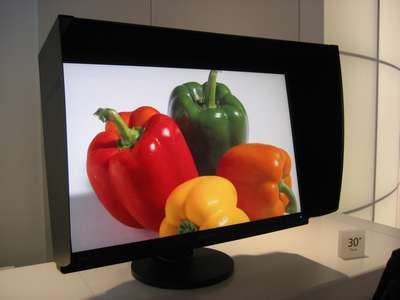
Samsung XL30

Samsung XL30
Both models are delivered with a so-called hood; a cover to prevent sunlight and external light sources to effect the picture.
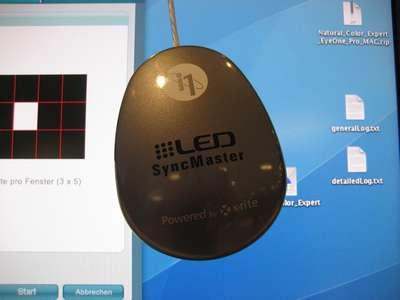
Samsung Calibrator
I walked past this new 19 inch widescreen monitor too. It’s called 931cw and has a colour specter of 90 % compared to NTSC.
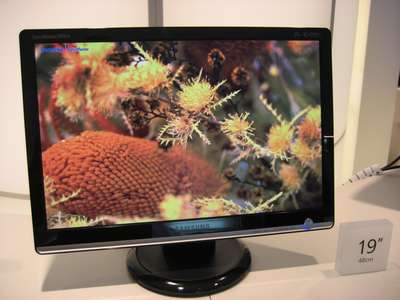
Samsung 931cw
Samsung showcased some 3D monitors. The idea is to integrate two panels inside a monitor to create depth – no much 3D about them though.
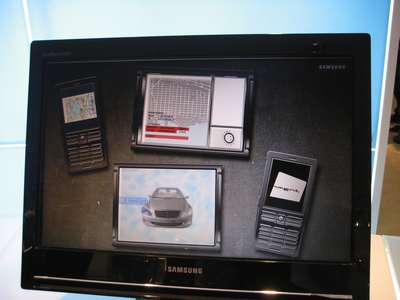
Samsung 3D monitor
It was a fun idea but nothing spectacular.
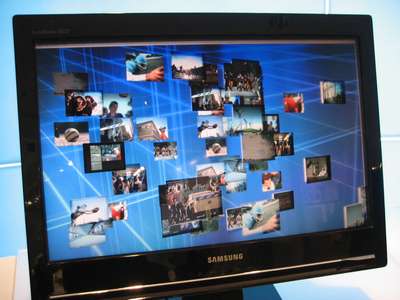
Samsung 3D monitor
I can’t really find any practical uses for these prototypes. It might serve as a stepping stone to real 3D monitors but I’m not convinced. It was called SD22.
Samsung has a new 19 inch designer monitor on display too. It’s supposed to replace the 931BF and is named… Tadadadaaa… Samsung 932BF. It has a very nice design though and won an iF product design award.
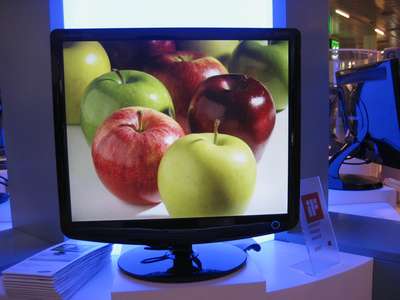
Samsung 932BF
You might notice the parallel to Samsung’s TVs that served as inspiration.
923BF has a TN panels with a resolution of 1280x1024, a contrast ratio of 700:1 (2000:1 dynamic) and a response time of 2 ms (g2g).
One of the hot monitors at the moment is the 206BW. It’s very popular here in Denmark because of the nice design, widescreen format and low price. It was showed off at CeBIT too.
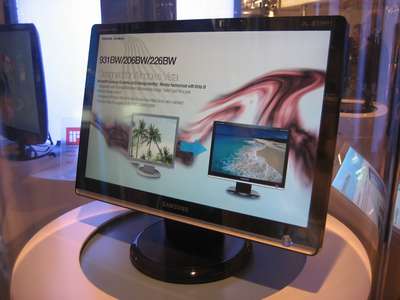
Samsung 206BW
Samsung launched the 960BF some time ago but it never got much glory. It had a nasty Overdrive trailing issue but it was pretty. The successor is 961BG and let’s hope it deals with the Overdrive technology more successfully.
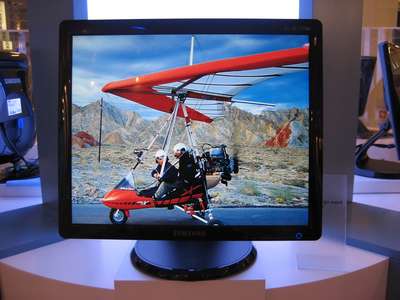
Samsung 961BG
961BG – or 961BF – has a TN panel with a response time of 2 ms (g2g) and a contrast ratio of 1000:1. It’s a 19 inch panel.
A widescreen edition is ready too. It’s named 961GW and has a similar design that won the reddot design award – it has to be good then, wauw.
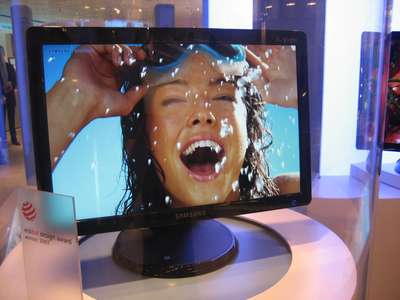
Samsung 961GW
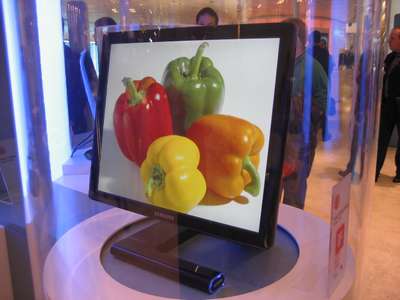
Samsung 971P
I had hoped to see the new 971P+ and the 20 inch widescreen model 2071BW but they were nowhere to be found which was disappointing.
I found another 19 inch widescreen monitor called 932GW. I guess it’s the widescreen edition of the 932BF because the design is almost similar. It too got a design award – what’s up with this? A design award..? Who in their right mind made themselves a judge of good design?
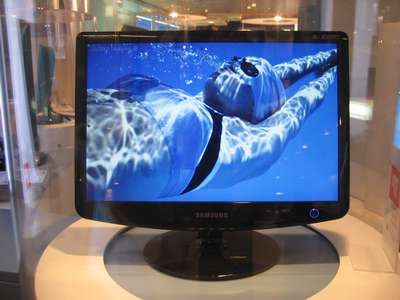
Samsung 932GW
Samsung will introduce this bad boy 30 inch widescreen monitor soon. It’s called 305T, has an S-PVA panel and a stunning resolution of 2560x1600. The contrast is 1000:1 and the response time measures 6 ms (g2g).

Samsung 305T
A companion has been annoucned and it’s the 27 inch monitor with the model number 275T. It has a S-PVA panel with a resolution of 1920x1200
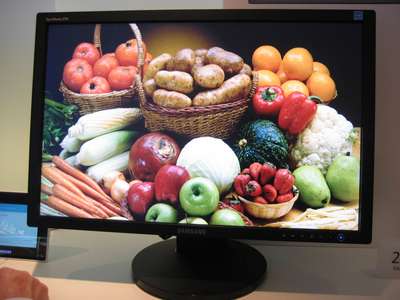
Samsung 275T
The 275T also has a S-video og component input.
The 245B also found its way onto Samsung’s floor. It’s a 24 inch TN monitor.
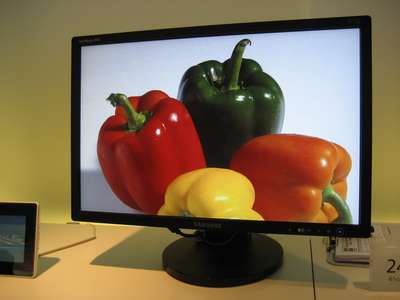
Samsung 245B
It has a resolution of 1920x1200 and a contrast ratio of 1000:1. The viewing angles are 160 dregrees.
I went on to take a look at the new TVs from Samsung. It was a tame view and not much effort has been put into this segment at CeBIT 2007.
One of the few interesting new additions was the M87 series. It’s the successor to M71 that never really made it big because of the crappy Smooth Motion system.
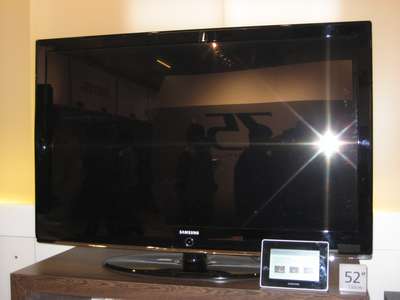
Samsung M87
I was introduced to this 52 inch TV called LE-52M75BD with a built-in digital tuner box.
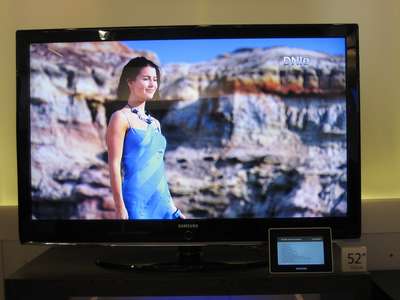
Samsung M86
The M86 series is Full HD and supports 1080p inputs.
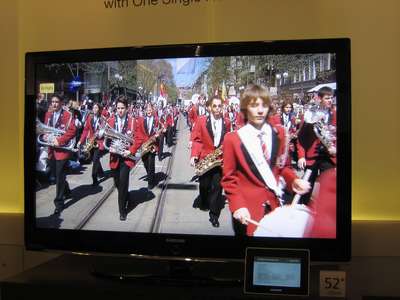
Samsung M86
Samsung also bragged about their new Super Clear Panel technology which basically is a blank coating on the outmost surface of the panel – just like the one plasma manufacturers try to eliminate.
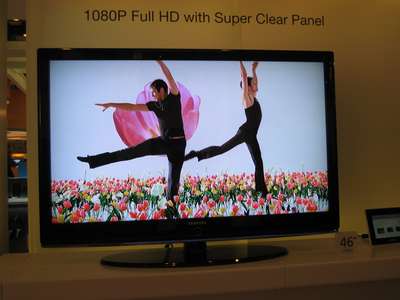
Samsung Super Clear Panel
The M86 series has 3 HDMI inputs (rev. 1.3) and a dynamic contrast ratio of 15000:1.The stand can tilt too.
A new line called R81 was on display next to the M87. It’s the next generation of the R7x and you can easily find the parallel in the design philosophies.
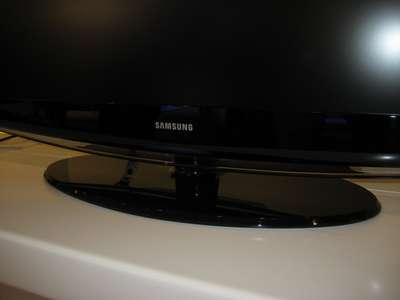
Samsung R81
The R81 series has a resolution of 1366x768 and a S-PVA panel. The contrast is 8000:1 (dynamic) and it has 3 HDMI inputs.
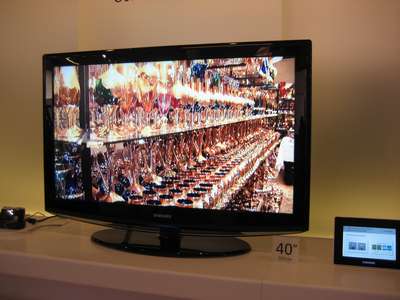
Samsung R81
The stand can tilt.
I never found the cheap S8 models but I did find the new Q9 plasma.
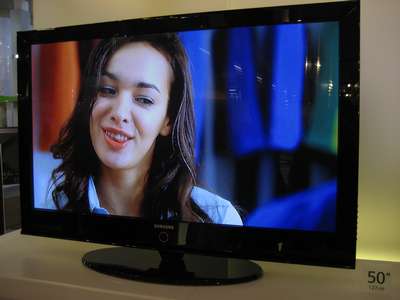
Samsung PS50Q96HD
The 50 inch mode, PS-50Q96HD has a resolution of 1365x768 and a contrast ratio of 15000:1. It features 3 HDMI inputs and a number of different picture circuits.
Sharp
As usual, Sharp is on the cutting edge of the newest LCD technology. They didn’t have as much new products to brag about this year but the 108 inch bad ass LCD-TV did manage to attract a lot of attention.
And I understand why. It is very impressive but the picture, however, needs a final touch – it’s not perfect.
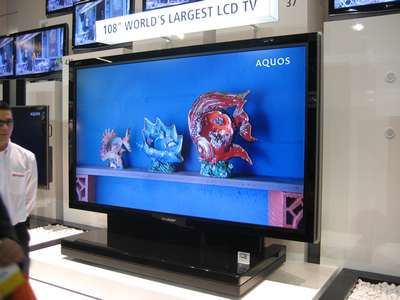
Sharp 108 inch LCD-TV
The 108 inch screen has been made by using two separate panels. If you look closely you can see a small joint of panels in the middle of the TV. It’s not visible at a reasonable distance but you might notice it from the sides.
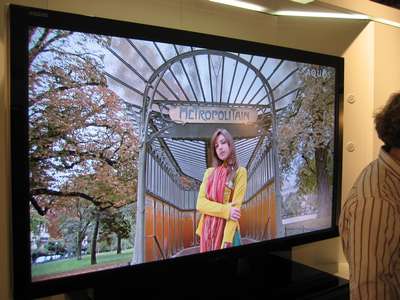
Sharp 108 inch LCD-TV
Another impressive presentation consists in the 4Kx2K screen made by Sharp. It has 4 times the resolution of a 1920x1080 TV and to be precise it is 4096x2160. This is distributed on a 64 inch panel and the picture is very impressive. You could argue that it’s unnecessary when you use it as a TV but I can find thousands of uses for this brilliant screen.

Sharp 64 inch 4Kx2K LCD
It’s a prototype for now and no plans to mass produce it have been announced.

Sharp 64 inch 4Kx2K LCD
Sharp used still pictures on the panel so no moving objects could be observed. The presentation did, however, manage to demonstrate just how many details a picture can hold.
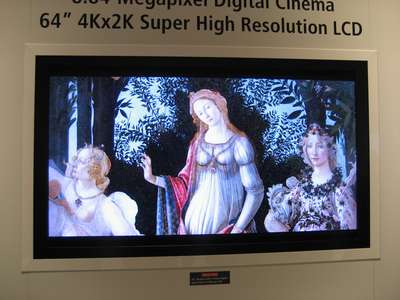
Sharp 64 inch 4Kx2K LCD
The level of details was very, very high and there’s a major difference between this 4Kx2K panel and a conventional 1920x1080 panel.
Before I move on to see some of the real consumer products I took a look at the Mega Contrast demonstration from Sharp. I saw the same thing on IFA 2006 but it’s very imposing. Here you see a comparison of the Mega Contrast screen and a conventional LCD panel.
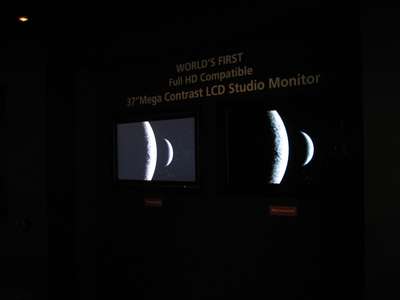
Sharp Mega Contrast
The difference is huge.
Sharp had more moving pictures this year and it’s amazing to see how the contrast and black levels in the screen really contributes to the overall picture quality. In my opinion the level of black is one of the most important aspects of good PQ (picture quality).

Sharp Mega Contrast
Most scenes were from the big black universe and we never saw any nature or bright images.
Sharp had their highly praised XD1 series on display too. Here you see the 52 inch. 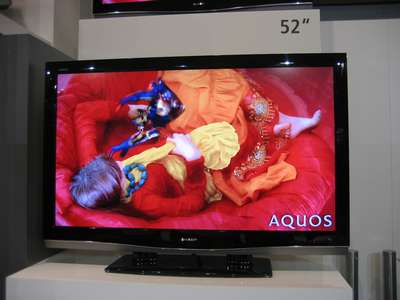
Sharp 52XD1
Sharp exhibited their new HD1 with a very crisp picture. It has a – real – contrast ratio of 3000:1 and many of the XD1 characteristics.
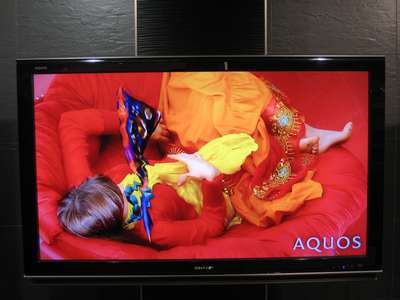
Sharp HD1
The HD1 series is Full HD and uses a 100 Hz technology to improve response time and reduce trailing.
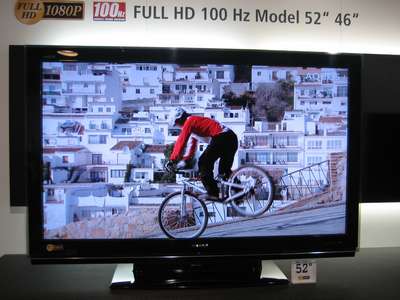
Sharp 52HD1
It also has a HD tuner (for mpeg-4) and a DVD-T, DVB-S and DVB-C tuner.
A third model was shown off here. It had no name however.

Sharp LCD-TV
Here you see a demonstration of the 100 Hz technology. Half of the screen had 100 Hz activated and the other half didn’t. It showed a very big difference but of course you can’t rely on these sales demonstrations.
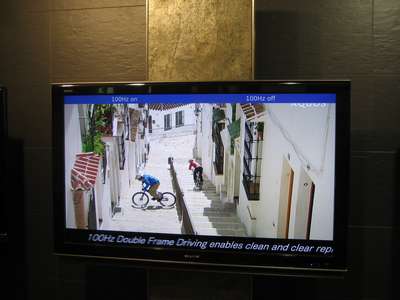
Sharp 100 Hz
It made text appear sharper but besides that I couldn’t recognize the blurry text on the side without 100 Hz on the other TVs from Sharp.
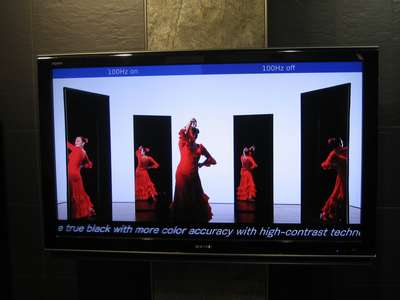
Sharp 100 Hz
Here you see two of the new mid-end TV series from Sharp. I didn’t catch the name
The first one
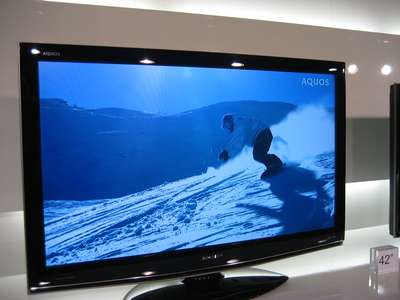
Sharp LCD-TV
The second one.
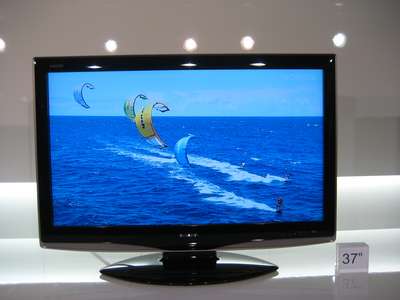
Sharp LCD-TV
This one had a contrast ratio of 1200:1 and a response time of 6 ms (g2g). An anti-judder technology has been implemented too.
I’m about to leave the Sharp booth now but before I do I want to show you their new Blu-Ray player called BD-HP10S.
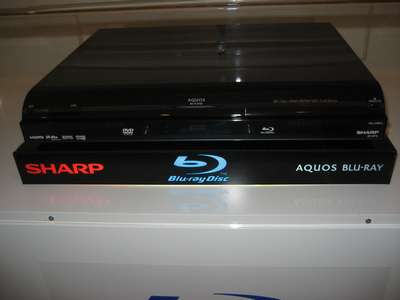
Sharp BD-HP10S
Sharp BD-HP10S supports 1080p output via HDMI
It has a 7.1 analogue output as well as optical and coaxial.
The player has backward compatibility with DVD’s and will be able to upscale to 1080p. It has a Quick Start technology that allows for a quicker start-up time.
Panasonic
Panasonic recently introduced their 2007 line-up so I was excited to see it at CeBIT 2007. To me big frustration not every TV was to be found. I asked one of the Pana dudes and he couldn’t show me the PX700 and PX70.
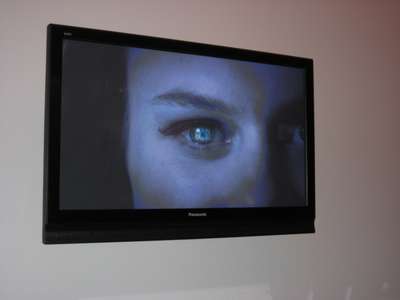
Panasonic PZ71 serien
I took a look at the PZ71 models instead. This is the Full HD plasma series. Panasonic had a cozy home cinema set-up so I stayed here for a while to rest my tired legs.
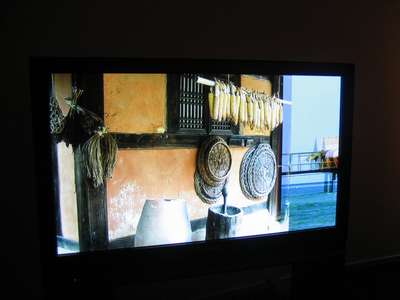
Panasonic PZ71 serien
This gave me the opportunity to really study the new PZ71 series and despite the fact that I wasn’t alone and a lot of people had the same goal I must say that I’m very impressed with Panasonics’ PZ71 series. A major improvement was visible and the picture was crisp and very clear.
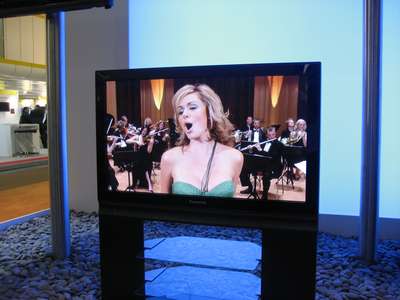
Panasonic PZ71 serien
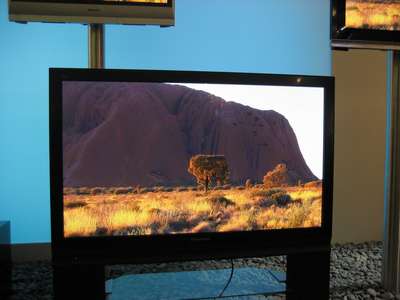
Panasonic PZ71 serien
Panasonic exhibited some Viera TVs too. You can see them here.
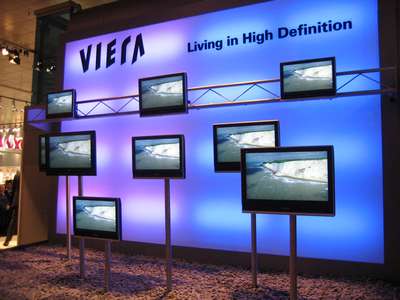
Panasonic Viera
When I finally tear myself away from the comfortable sofas I found the 103 inch plasma screen from Panasonic. It’s wasn’t readly hard to find but you know…
The picture quality is very good but the reflection in the surface of the panel is a problem.
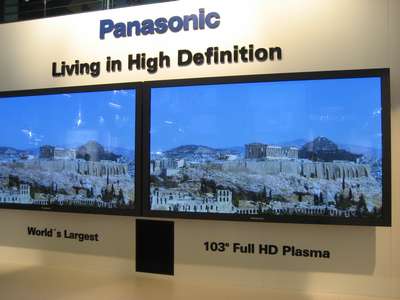
Panasonic 103 inch plasma
Some different scenes to look at.
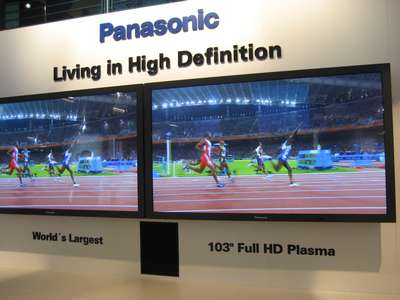
Panasonic 103 inch plasma
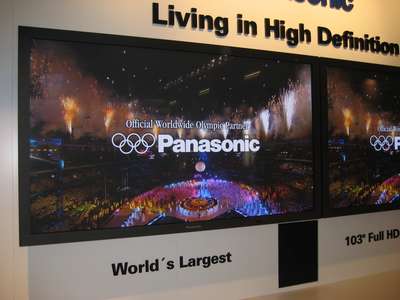
Panasonic 103 inch plasma
Toshiba
Toshiba wished to promote their new TVs and of course HD-DVD. Toshiba is one of the large HD-DVD supporters and at the moment the only manufacturer to really launch new HD-DVD players on a big scale.
One of the new HD-DVD players is this HD-EP10 that will arrive in May.

Toshiba HD-EP10
HD-EP10 has an HDMI output that supports 1080p.
HD-EP10 supports DTS HD, Dolby HD and the old DTS and Dolby Digital.
Toshiba said that 1080p/24 will be supported through a firmware update in July. This goes for the HD-XE1 as well.
Here you see the current HD-XE1 and HD-E1.
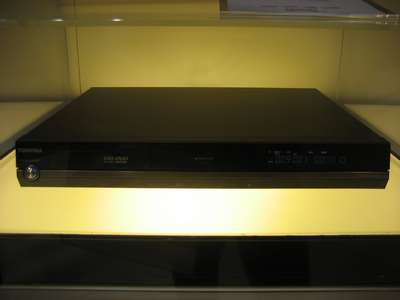
Toshiba HD-E1
HD-E1 is the smaller player with no 1080p support.
Toshiba HD-XE1 is the high-end player with a nice brushed aluminum design. It supports 1080p and the new sound formats.
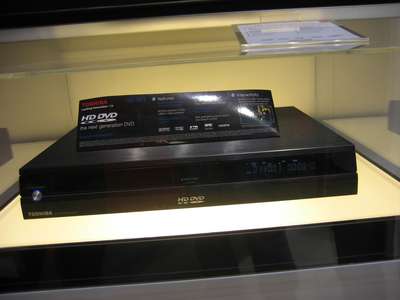
Toshiba HD-XE1
HD-ZE1 has an advanced video circuit too as well as 5.1 analogue output.
All of the HD-DVD players have a Internet input to collect movie trailers and firmware upgrades.
Toshiba had brought their new C3000 series to CeBIT. C3000 is going to replace the WL66 series as a mid-end value model.
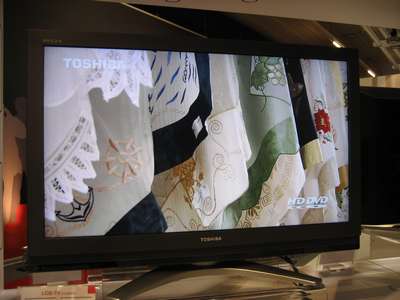
Toshiba 42C3000P
Here you see the 42 inch C3000 called 42C3000P.
42C300P has a resolution of 1366x768 and a contrast ratio of 4000:1 (dynamic), an 8 ms response time and 178 degrees viewing angles.
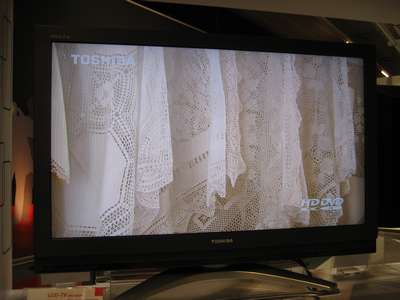
Toshiba 42C3000P
The C3000 series will support 1080p input in both of the HDMI inputs. It also has the Pixel PRO III+ picture curcuit.
One of the new additions to the portfolio is WLT68. Here you see the 42 inch.

Toshiba 42WLT68P
WLT68 has the same specs as the C3000 but features a 100 Hz technology.
It also has a DVB-T tuner and 3 HDMI input.
A Full HD line is introduced under the name WL67 and has a contrast ratio of 800:1 and a response time of 6.5 ms.

Toshiba 42WL67Z
The WL67 series has 2 HDMI inputs and the Pixel Processing III + circuit.
Another new line of TVs was shown. It’s the X3000 that should appeal to the demanding group ofcustomers.
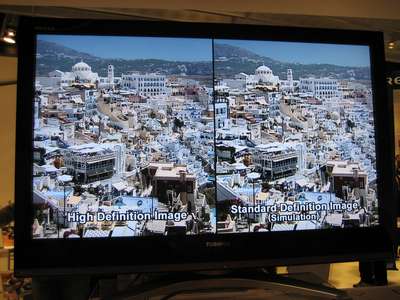
Toshiba 42X3030D
The X3000 TVs use a Full HD panel that accepts 1080p input at 60, 50 and 24 Hz. It has 2 HDMI inputs and a contrast ratio of 6000:1. The response time is 8 ms and the viewing angles have been specified to be 176 degrees.
The X3000 series has a built-in DVB-T tuner and a picture system called Pixel Processing IIII Pro.
To finish off this CeBIT 2007 coverage here’s a picture from Toshiba’s booth with a lot of HD-DVD movies.
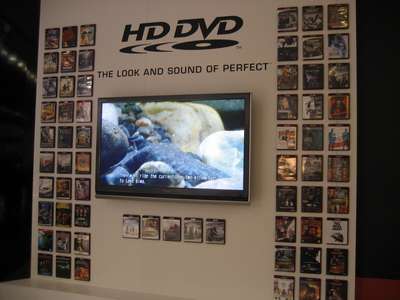
Toshiba HD-DVD
That’s all folks. See you next time – probably on CES 2008.

